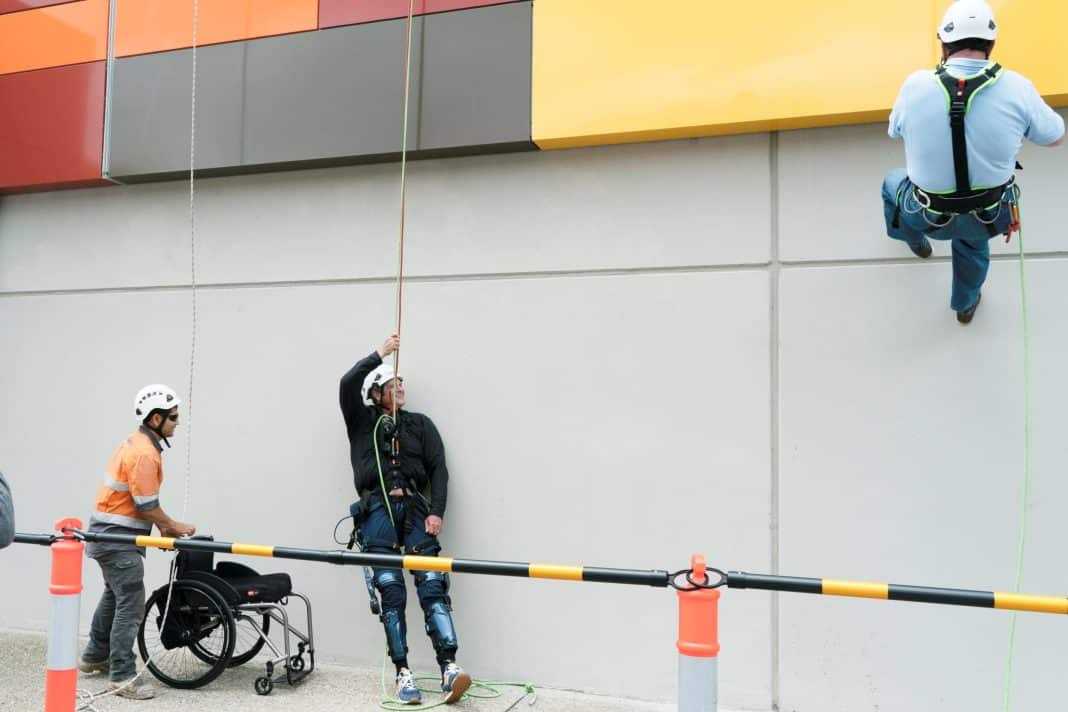Last Friday, former cricket champion Chris Cairns, paralysed after a spinal stroke last year, used a robotic exoskeleton to abseil 18 metres down Canberra Hospital, to raise funds for the Canberra Hospital Foundation.
Since February, Mr Cairns has been using the motorised orthosis, the $70,000 Keeogo, at the University of Canberra Hospital (UCH), a rehabilitation hospital operated by Canberra Health Services, to learn how to walk again.
The hospital will soon bring in more of these futuristic devices to help other stroke and spinal cord injury victims walk again.
Pending procurement activities, CHS anticipates the robotic rehabilitation unit will be operational in early 2023.
With the help of the Canberra Hospital Foundation, UCH intends to purchase upper limb devices to help patients reach and feed for themselves, and lower limb devices.
“Some of these devices can double the odds of an individual to walk independently again, when used in conjunction with physiotherapy,” Professor Nick Brown, Professor of Allied Health Research, said.
Equipment will be used by both inpatients and outpatients at UCH, and can be used by all rehabilitation teams.
The devices UCH will purchase are larger than the Keeogo that Mr Cairns used to abseil.
“They are for people post-stroke who have no function at all,” Professor Brown said.
“We will set them up, so they can either practise walking, or practise arm and reaching movements. That’s important early in the phase of recovery for someone with a stroke. If they can do lots of movements, that can help the brain recover from the stroke, and walk again independently.”
The device used by Chris Cairns was organised privately, and CHS provided support and therapy to use the exoskeleton as part of the services offered at UCH.
Internationally, these devices have been used for 15 years. The first rehabilitation robots for stroke victims came out of Switzerland in the early 2000s, he said – but they have only come to Australia recently. For instance, Australia’s first robot powered therapy centre, RoboFit, was set up in Sydney last year, while the Adelaide Women’s and Children’s Hospital opened the first robotic rehabilitation gym, for children with serious neurological conditions, in 2017.
“It’s emerging – but it’s an opportunity, definitely, for Canberra and for clinicians across Australia to provide enhanced care for this type of patients, who are notoriously difficult to help,” Professor Brown said.
The exoskeleton matches the user’s anatomy, he explains. It lines up with the ankle, knee, and hip joints; motors about those joints help the muscles that don’t function properly, allowing the user to sit or stand, and supporting their body weight. It is, he said, “very clever control technology”.
How long it takes to learn to use the exoskeleton depends on the type of injury, Professor Brown said. For people with partial muscle dysfunction, it can be quite quick; at RoboFit, people with spinal injuries can be up and moving within an hour. But people who lose almost all function take longer. Others might need a couple of weeks to adopt and use the technology.
The devices reduce the manual load on the therapist, Professor Brown explains.
“Instead of a physiotherapist having to move a leg 100 times manually with their own hands, the robot can do 600 of those movements while the physio is doing something more important with the patient.”
The robots, he emphasises, supplement, but do not replace, physiotherapy.
“These can’t be used independently of really good therapy. These are not the sole solution.
“They need to be an adjunct to high level medical care, good physiotherapy, good occupational therapy, exercise rehabilitation. All of those things combined are what help people like Chris, and what help people with stroke or spinal cord injuries get better.”
Canberra Daily is keen to hear from you about a story idea in the Canberra and surrounding region. Click here to submit a news tip.



